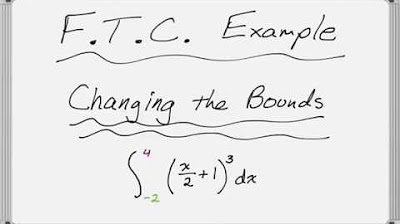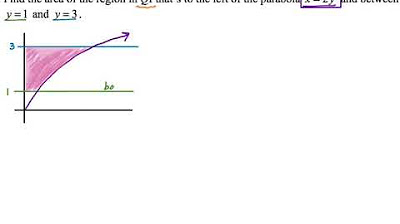Surface integral ex3 part 4: Home stretch | Multivariable Calculus | Khan Academy
TLDRIn this mathematical tutorial, the presenter concludes the evaluation of a complex surface integral over a specified region. By setting up the integral as a double integral with respect to r and theta, and carefully integrating with bounds r from 0 to 1 and theta from 0 to 2 pi, the presenter simplifies the expression. The final calculation results in the value of the original surface integral, which is determined to be 3 pi/2 plus the square root of 2 times pi, providing a satisfying resolution to the problem discussed across multiple videos.
Takeaways
- 📚 The video script is about evaluating a complex surface integral over a specific region.
- ✍️ The process begins by setting up the third surface integral as a double integral with respect to r and theta.
- 📈 The variable r ranges from 0 to 1, and theta ranges from 0 to 2 pi, defining the bounds of integration.
- 🔄 The integral is solved by first integrating with respect to r, treating cosine of theta as a constant.
- 🧮 After integrating with respect to r, the expression simplifies to (1/2 - 1/3 cos(theta))
- 🌟 The next step is to perform the integral with respect to theta, which results in the antiderivative expressions (1/2 theta - 1/3 sin(theta))
- 📊 The antiderivative expressions are then evaluated from 0 to 2 pi, leading to the final result.
- 🎯 The evaluation at 2 pi and 0 for the theta function results in the cancellation of terms, simplifying to pi.
- 🔢 The final answer for the third surface integral is the square root of 2 times pi (√2π).
- 🔍 The entire surface integral, which was the main focus of the video series, is broken down into three parts with their respective contributions to the final result.
- 📌 The final result of the original surface integral is 3 pi/2 plus the square root of 2 times pi (3π/2 + √2π).
Q & A
What was the main topic being discussed in the video?
-The main topic being discussed in the video was the evaluation of the third surface integral, specifically setting it up as a double integral with respect to r and theta.
What are the bounds for the integration with respect to r and theta?
-The bounds for the integration with respect to r are between 0 and 1, and for theta, it is between 0 and 2 pi.
How does the speaker simplify the expression for the inner integral?
-The speaker simplifies the expression for the inner integral by distributing the r and then integrating with respect to r, treating cosine of theta as a constant during the integration.
What is the antiderivative of r with respect to r?
-The antiderivative of r with respect to r is r squared over 2.
What is the antiderivative of r squared with respect to r?
-The antiderivative of r squared with respect to r is r cubed over 3 minus r cubed over 3 cosine theta, which simplifies to r cubed over 3.
What is the final result of the evaluation of the third surface integral?
-The final result of the evaluation of the third surface integral is the square root of 2 times pi, or √2π.
How does the speaker ensure accuracy in the final steps of the calculation?
-The speaker ensures accuracy by carefully evaluating the antiderivative at the bounds of integration and emphasizing not wanting to make a careless mistake.
What is the significance of the expression 'square root of 2 times pi' in the context of the integral?
-The expression 'square root of 2 times pi' represents the value of the third surface integral, which is part of the overall surface integral being evaluated in the series of videos.
What are the other two parts of the surface integral mentioned in the video?
-The other two parts of the surface integral mentioned are the orange part, which evaluates to 0, and the blue part, which evaluates to 3 pi over 2.
What is the final value of the original surface integral discussed in the video?
-The final value of the original surface integral is 3 pi over 2 plus the square root of 2 times pi.
How does the speaker approach the evaluation of the surface integral?
-The speaker approaches the evaluation by breaking it down into parts, setting up the double integral, and carefully integrating with respect to both r and theta, while also simplifying the expressions at each step.
Outlines
📚 Evaluating the Third Surface Integral
The paragraph begins with the speaker stopping a previous video due to its length and the need for a break. The speaker then continues from where they left off, which is the evaluation of the third surface integral. They set up the integral as a double integral with respect to r and theta, with r ranging from 0 to 1 and theta from 0 to 2 pi. The speaker proceeds to integrate with respect to r first, outlining the process of setting up the integral and the bounds. The integral is rewritten, and the speaker explains the integration process, highlighting that when integrating with respect to r, cosine of theta becomes a constant. The antiderivative of r is found to be r squared over 2, and the antiderivative of r squared is r cubed over 3 minus r cubed over 3 cosine theta. The speaker evaluates these from 0 to 1, simplifying the expression to 1/2 minus 1/3 cosine theta. The speaker then evaluates the integral from theta 0 to 2 pi, explaining the process of finding the antiderivative of the functions involved and evaluating them at the bounds. The final result simplifies to pi, marking the completion of the evaluation of the third surface integral. The speaker summarizes the results of the entire surface integral process, which began in previous videos, and concludes that the value of the original surface integral is 3 pi over 2 plus the square root of 2 times pi.
Mindmap
Keywords
💡Surface Integral
💡Double Integral
💡Antiderivative
💡Bounds
💡Integration
💡Cosine of Theta
💡Sine of Theta
💡Pi
💡Square Root of 2
💡Evaluation
💡Home Stretch
Highlights
The process of evaluating the third surface integral is discussed, which involves setting up a double integral with respect to r and theta.
The bounds for the integration are established, with r ranging from 0 to 1 and theta from 0 to 2 pi.
The double integral is set up, with the intention to integrate with respect to r first.
The integral is rewritten to facilitate the integration process, distributing the r term.
When integrating with respect to r, cosine of theta is treated as a constant.
The antiderivative of r with respect to r is found to be r squared over 2.
The antiderivative of r squared with respect to r is r cubed over 3 minus r cubed over 3 cosine theta.
The evaluation of the integral at r=1 yields 1/2 minus 1/3 cosine theta.
The evaluation of the integral at r=0 results in 0, as expected.
The integral simplifies to 1/2 minus 1/3 cosine of theta when considering the bounds.
The next step is to perform the integral with respect to theta, which involves the antiderivative of 1/2 which is 1/2 theta and the antiderivative of cosine theta which is sine theta.
The evaluation of the integral at theta=2 pi results in pi, as sine of 2 pi equals 0.
The integral evaluates to the square root of 2 times pi, denoting the value of the third surface integral.
The overall process concludes with the evaluation of the original surface integral, which sums up to 3 pi over 2 plus the square root of 2 times pi.
The conclusion of the 80-video series is reached, with a comprehensive evaluation of the surface integral.
Transcripts
Browse More Related Video

Surface integral ex3 part 2: Evaluating the outside surface | Multivariable Calculus | Khan Academy

2011 Calculus BC free response #3 (b & c) | AP Calculus BC | Khan Academy

Fundamental Theorem of Calculus: Changing the Bounds with u-Substitution

Area Between Curves: Integrating with Respect to y (Example 1)

Surface integral example part 3: The home stretch | Multivariable Calculus | Khan Academy

Improper Integrals - Infinite Bounds
5.0 / 5 (0 votes)
Thanks for rating: